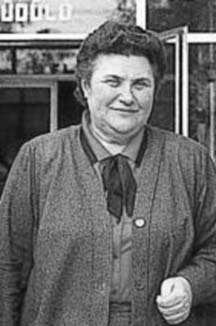


 تاريخ الرياضيات
تاريخ الرياضيات
 الرياضيات في الحضارات المختلفة
الرياضيات في الحضارات المختلفة 
 الرياضيات المتقطعة
الرياضيات المتقطعة
 الجبر
الجبر
 الهندسة
الهندسة 
 المعادلات التفاضلية و التكاملية
المعادلات التفاضلية و التكاملية 
 التحليل
التحليل
 علماء الرياضيات
علماء الرياضيات |
Read More
Date: 20-2-2018
Date: 21-2-2018
Date: 25-2-2018
|
Born: 2 July 1925 in Kiev, Ukraine
Died: 13 October 2001 in Moscow, Russia

Olga Arsenievna Oleinik's parents were Arsenii Ivanovic and Anna Petrovna. She grew up during difficult years in Russia, and the Second World War caused much hardship and destruction. Despite the difficulties she graduated from the Moscow State University in 1947, and continued her graduate work there. She received her Master's degree in 1950, and her Doctor's degree in 1954. Her doctoral studies were supervised by Ivan Georgievic Petrovsky and after his death in 1973, she wrote several tributes to her doctoral supervisor:-
Petrovsky's knowledge was encyclopaedic. He had a thorough understanding of modern science and all its interconnections, was perspicacious and far-sighted, was able to discern long-term trends, and always emphasised them. He also showed a wide general culture, knowledge of diverse branches of science, a deep understanding of state problems in many outstanding public and state activities.
Given Petrovsky's expertise in differential equations, the topology of algebraic curves and surfaces and mathematical physics, it is not difficult to see his influence on the direction that Oleinik's work would take. She too became a leading world expert in these areas. After the award of her doctorate she remained at Moscow State University where she became professor of mathematics. In 1973 she became Head of the Department of Differential Equations at Moscow State.
It is impossible to give more than just an indication of her work in an article of this type since her contributions are so extensive. Mathematical Reviews lists 359 publications under her name, an almost unbelievable achievement for any mathematematician. To see just how impressive having 359 publications is, we should note that most top mathematicians would be proud of having 100 publications in their careers and 200 is quite exceptional.
Let us look at a few monographs which she published in the last 10 years of her life. In 1990, together with G A Iosifyan and A S Shamaev, she published Mathematical problems in the theory of strongly inhomogeneous elastic media. It is a work in three chapters which studies the mathematical theory of perforated elastic bodies and builds into one volume many papers that Oleinik and her two coauthors had produced in the preceding 10 years. The three chapters are: Basic mathematical aspects of the theory of elasticity; Homogenization of the equations of linear elasticity; Composites and perforated materials and Spectral problems in homogenization theory. Mikelic, in reviewing the book, writes:-
This is an impressive monograph on homogenization in linear elasticity. It is self-contained and the reader with background in partial differential equations and continuum mechanics can learn the homogenization techniques developed by Oleinik and her coauthors.
In 1993, together with V V Zhikov and S M Kozlov, Oleinik published a Russian work Averaging of differential operators and in the following year an English translation appeared with the title Homogenization of differential operators and integral functionals. The Russian book has 15 chapters, while the English edition is an updated and expanded version with 17 chapters:-
Without a doubt, this book promotes an important new stage in homogenization theory.
In 1996 Oleinik published Some asymptotic problems in the theory of partial differential equations. Many results which Oleinik obtained over the previous years appear in this volume for the first time. Much of the book is devoted to the study of the asymptotic behaviour of solutions to nonlinear elliptic second-order equations. Oleinik considers equations satisying Dirichlet boundary conditions and ones which satisfy Neumann boundary conditions. Oleinik also studies the homogenization problem for linear elliptic equations in domains with the property that half is perforated and half contains no holes.
Oleinik published Mathematical methods in boundary-layer theory in 1997, jointly with V N Samokhin. Fife revied the 512 page volume and wrote:-
This book is a vast treasury of rigorous mathematical results about the Prandtl systems of partial differential equations in fluid dynamics. Oleinik and her many collaborators are responsible for developing most of this theory over the last four decades.
The Prandtl equations were devised early in this century as a simpler replacement for the Navier-Stokes equations to describe viscous laminar fluid flows near boundaries to which the fluid adheres. These replacement equations have a quite different mathematical character than the Navier-Stokes equations, and as one can easily see from this book, the theory goes along very different lines.
Oleinik received many honours for her work. She was elected to: the Russian Academy of Sciences; the Academia Nazionale dei Lincei in Italy; the Sächsische Akademie of Sciences in Germany; the Italian Academy of Sciences in Palermo; the Italian Academy of Sciences in Milan; and the Royal Society of Edinburgh in Scotland. She received many prizes for her remarkable contributions: the Chebotarev Prize; the State Prize; the Lomonosov Prize; the Petrowsky Prize; and the Prize of the Russian Academy of Sciences. She received medals from the Collège de France and the Charles University of Prague.
In 1981 University of Rome gave Oleinik an honorary doctorate and in 1996 Oleinik was the Association for Women in Mathematics Noether Lecturer.
One of her colleagues paid this tribute to her on her death:-
She will also be remembered as a lady with a very strong personality. She was very generous with her colleagues and her friendship, once acquired, was limitless. Her loss will be deeply felt by the international mathematical community.
Articles:



|
|
|
|
هل يمكن أن تكون الطماطم مفتاح الوقاية من السرطان؟
|
|
|
|
|
|
|
اكتشاف عرائس"غريبة" عمرها 2400 عام على قمة هرم بالسلفادور
|
|
|
|
|
|
|
جامعة الكفيل تقيم ندوة علمية عن الاعتماد الأكاديمي في جامعة جابر بن حيّان
|
|
|